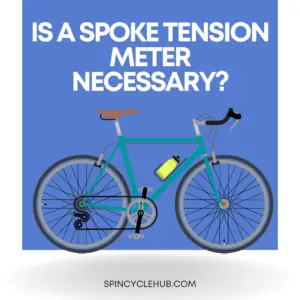Have you ever wondered about the importance of spoke tension in bicycle wheels? Well, let’s dive into this topic and find out if a spoke tension meter is truly necessary or just an optional tool for bike enthusiasts.
Why do you need a spoke tension meter?
Bicycles rely on a well-built wheel for optimal performance, and spoke tension plays a crucial role in ensuring the wheel’s strength, stability, and trueness. A spoke tension meter helps you measure and maintain the proper tension in each spoke, ultimately contributing to a better riding experience.

Understanding Spoke Tension
Before we delve into the necessity of a spoke tension meter, let’s quickly understand the significance of spoke tension in a bicycle wheel. Spokes are the thin, metal rods that connect the rim to the hub, and their tension affects the overall performance of the wheel.
How spokes affect wheel performance
Spokes work together to distribute the forces and weight applied to the wheel during riding. Properly tensioned spokes enable the wheel to withstand these forces and maintain its shape. Insufficient or uneven tension can lead to a host of problems, including wheel wobbles, spoke breakage, and compromised stability.
The Importance of Proper Spoke Tension
Now that we know how spokes contribute to wheel performance, it becomes evident that maintaining proper spoke tension is vital.
Impact on wheel strength and durability
When all spokes have consistent tension, they share the load equally, creating a stronger and more durable wheel. This is particularly important for riders who encounter rough terrain or engage in aggressive riding styles. Proper tension helps prevent spoke fatigue, which can lead to costly wheel repairs or even catastrophic failures.
Influence on wheel trueness and stability
Spokes with uneven tension can cause the wheel to go out of true, meaning it develops a side-toside wobble. This not only affects the ride quality but also increases the risk of spoke breakage and further wheel damage. With proper spoke tension, the wheel stays truer for longer, providing a more stable and enjoyable ride.
Challenges in Assessing Spoke Tension
Assessing spoke tension visually may seem like a viable option, but it comes with limitations and uncertainties.
Visual inspection: Is it reliable?
While experienced mechanics can gauge tension by observing spoke deflection or plucking them like guitar strings, this method is subjective and prone to error. Factors such as spoke thickness, rim depth, and spoke type can affect the accuracy of visual cues. Plus, relying solely on visual inspection may not identify subtle tension variations between spokes.
The Benefits of Using a Spoke Tension Meter
Now, let’s address the question at hand: Is a spoke tension meter necessary? The answer lies in the benefits it offers.
Precision and accuracy
A spoke tension meter provides precise measurements of the tension in each spoke, eliminating the guesswork and subjectivity of visual inspection. With accurate readings, you can ensure that every spoke is within the recommended tension range, promoting wheel strength and durability.
Ensuring consistent tension across all spokes
A tension meter allows you to identify any discrepancies in spoke tension and make necessary adjustments. Achieving consistent tension across all spokes helps distribute the load evenly, maintaining wheel trueness and reducing the risk of spoke failure. It’s like tuning each spoke to play its part in creating a well-balanced wheel symphony.
How to Use a Spoke Tension Meter
Using a spoke tension meter is a straightforward process. Here’s a step-by-step guide to help you get started:
- Selecting the appropriate meter: Choose a tension meter that suits your budget, preferences, and the type of wheels you’ll be working with. There are various options available, ranging from analog gauges to digital devices with additional features.
- Attaching the meter and adjusting calibration: Follow the manufacturer’s instructions to attach the meter to the spoke and calibrate it correctly. Each tension meter may have specific guidelines, so be sure to read the user manual for accurate results.
- Reading and interpreting tension values: With the meter properly attached, measure the tension of each spoke by plucking it or applying pressure as instructed by the meter. Take note of the tension values and compare them to the recommended range provided by the wheel or spoke manufacturer. Adjust any spokes that fall outside the desired range until they reach the appropriate tension.
By following these steps, you can effectively use a spoke tension meter to ensure your wheels maintain the optimal tension for a smooth and reliable ride.
Common Misconceptions about Spoke Tension
Before we make a final judgment on the necessity of a spoke tension meter, let’s address a couple of common misconceptions:
“I can rely on feel and sound”
While experienced mechanics may have a good sense of spoke tension through feel and sound, it takes years of practice and a trained ear to develop this skill. For most riders, relying solely on feel and sound is unreliable and can lead to inconsistent tension, potentially compromising the wheel’s performance.
“Spoke tension doesn’t matter unless the wheel is visibly out of true”
It’s a common misconception that spoke tension only needs attention when the wheel visibly appears out of true. However, by then, the spokes may already be under excessive stress, and the wheel’s stability and strength may be compromised. Regularly checking and maintaining proper spoke tension is a proactive approach to prevent such issues.
The Risks of Neglecting Spoke Tension
Neglecting proper spoke tension can have significant consequences, both in terms of safety and maintenance costs.
Wheel failure and safety hazards
Insufficient or unevenspoke tension increases the risk of wheel failure. When spokes are under excessive stress or have inconsistent tension, they are more prone to breaking, leading to a catastrophic wheel collapse while riding. This poses a serious safety hazard to the rider and others around them.
Increased maintenance and repair costs
A wheel with poor spoke tension requires more frequent truing and maintenance to keep it in shape. The constant need for adjustments can be time-consuming and costly if you rely solely on professional bike mechanics. By investing in a spoke tension meter and regularly checking and adjusting spoke tension yourself, you can save money in the long run by reducing the need for frequent repairs.
Factors to Consider when Choosing a Spoke Tension Meter
If you decide to invest in a spoke tension meter, consider the following factors to ensure you choose the right one for your needs:
Price range and budget
Spoke tension meters come in a wide range of prices, from budget-friendly options to high-end models. Determine your budget and find a meter that provides accurate readings within your desired price range.
Features and functionality
Different tension meters offer varying features and functionality. Consider whether you prefer a digital or analog meter, additional capabilities such as Bluetooth connectivity or compatibility with different spoke types and wheel sizes. Assess your specific requirements to select the meter that suits you best.
Alternatives to Spoke Tension Meters
While a spoke tension meter provides the most accurate and reliable measurements, there are alternatives available if you’re unable to invest in one:
Professional assistance from bike shops
If you don’t own a spoke tension meter or feel uncomfortable making adjustments yourself, you can always seek professional help from bike shops. Experienced mechanics can assess and adjust spoke tension for you, ensuring your wheels are in top shape.
DIY methods for estimating spoke tension
Although not as accurate as a tension meter, there are some DIY methods to estimate spoke tension. These include plucking the spokes and listening for consistent pitch or using a homemade deflection gauge. While these methods may provide a rough estimate, they are not as precise as using a dedicated spoke tension meter.
Conclusion
While it’s possible to maintain proper spoke tension through visual inspection or other DIY methods, using a spoke tension meter offers several advantages. It provides precision, accuracy, and consistency in measuring spoke tension, ultimately enhancing the strength, durability, trueness, and stability of your bicycle wheels. Investing in a spoke tension meter can save you time, money, and potential safety risks in the long run.

FAQs (Frequently Asked Questions)
- Do all bicycles require the use of a spoke tension meter? Not all bicycles require a spoke tension meter, especially if you only ride casually and don’t encounter extreme conditions. However, if you’re serious about maintaining optimal wheel performance, a tension meter can be a valuable tool.
- Can’t I just rely on the expertise of a professional bike mechanic? While professional bike mechanics have the knowledge and experience to assess and adjust spoke tension, having your own spoke tension meter allows you to perform regular checks and adjustments at your convenience, saving time and money on frequent mechanic visits.
- Are digital spoke tension meters more accurate than analog ones? Both digital and analog spoke tension meters can provide accurate readings when used correctly. The choice between the two depends on personal preference and the specific features you require.
- How often should I check the spoke tension on my bicycle wheels? It’s a good practice to check your spoke tension periodically, especially after encountering rough terrain or if you notice any wheel wobbles. Depending on your riding style and conditions, checking every few months or at least once a year should be sufficient.
- Can I use a spoke tension meter on other types of wheels, like motorcycle or wheel chair wheels? Spoke tension meters are primarily designed for bicycle wheels. While the basic principles of spoke tension apply to other wheel types, such as motorcycle or wheelchair wheels, the specific tension values and requirements may differ. It’s best to consult the manufacturer’s recommendations or seek professional advice for tensioning wheels other than bicycles.
- “The Importance of Spoke Tension“ – This article provides insights into the significance of spoke tension for bicycle wheels and the impact it has on overall wheel performance and safety.
- “How to Measure and Adjust Spoke Tension“ – This comprehensive guide offers step-by-step instructions on using a spoke tension meter to measure and adjust spoke tension effectively, ensuring a properly tensioned wheel.
Watch this one,
Video Credits – Jim Langley
DOWNLOAD THIS ARTICLE :Click Here
You May Also Like



